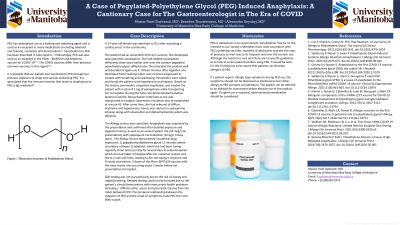Tuesday Poster Session
Category: Practice Management
P4097 - A Case of Pegylated-Polyethylene Glycol (PEG)-Induced Anaphylaxis: A Cautionary Case for the Gastroenterologist in the Era of COVID
Tuesday, October 24, 2023
10:30 AM - 4:00 PM PT
Location: Exhibit Hall

Has Audio

Maziar Fazel Darbandi, MD
University of Manitoba
Winnipeg, MB, Canada
Presenting Author(s)
Maziar Fazel Darbandi, MD, Branden Thorsteinson, MD, Alexandra Ilnyckyj, MD, FRCPC
University of Manitoba, Winnipeg, MB, Canada
Introduction: Polyethylene glycol (PEG) has widespread use as a bulking and stabilizing agent and is used as an excipient in many medications, cosmetics and food products<sup>1</sup>. Sensitization to PEG has been described in case reports<sup> 2</sup>. Interestingly, PEG was also used as an excipient in the Pfizer - BioNTech and Moderna vaccine for COVID-19<sup>3–7</sup>. The COVID vaccines differ from previous common vaccines in this regard<sup>3–6</sup>.
Case Description/Methods: A 37-year-old female was admitted to ICU after sustaining a cardiac arrest in the community.
The patient had an uneventful delivery by C-section. She developed post-operative constipation. She had treated constipation effectively three years earlier with over the counter pegylated PEG, @Restorolax. She tolerated the product well and decided to again use it. Fifteen minutes after ingestion she developed hand swelling which over minutes progressed to trouble with breathing and swallowing. Paramedics were called and found the patient to be hypotensive and hypoxic. Anaphylaxis was suspected and the patient was treated with a total of 5 mg of epinephrine while transported to hospital. Systematic circulation was re-established at minute 45.
The Allergy service was consulted. Anaphylaxis was suspected by the presentation and confirmed after detailed exposure and ingestion history, as well as, an acute tryptase rise (34 mcg/L on presentation) with subsequent normalization (1mcg/L 6 days later). The Allergy service documented 4 potential drug exposures; pegylated-PEG, labetalol, acetaminophen, and Covid vaccination. Skin testing was not pursued early due to the risk of anergy and negative testing. Delayed testing could not be pursued due to the patient’s clinical deterioration with intercurrent complications. The temporal relationship between the ingestion of PEG and the onset of symptoms make PEG the most likely culprit.
Discussion: PEG is ubiquitous in our environment. Sensitization may be on the increase as our society undertakes mass scale vaccination with PEG containing vaccines, however, GI physicians may see this class of products as inert due to its frequent and over the counter use. Although the reaction is rare and there are no specific guidelines as to how to screen patients before using PEG, it would be wise for the GI physician to be aware that patients can develop allergies to PEG. If a patient reports allergic type symptoms during PEG use, the symptoms should not be dismissed as intolerances but rather, allergy to PEG warrants consideration.
Disclosures:
Maziar Fazel Darbandi, MD, Branden Thorsteinson, MD, Alexandra Ilnyckyj, MD, FRCPC. P4097 - A Case of Pegylated-Polyethylene Glycol (PEG)-Induced Anaphylaxis: A Cautionary Case for the Gastroenterologist in the Era of COVID, ACG 2023 Annual Scientific Meeting Abstracts. Vancouver, BC, Canada: American College of Gastroenterology.
University of Manitoba, Winnipeg, MB, Canada
Introduction: Polyethylene glycol (PEG) has widespread use as a bulking and stabilizing agent and is used as an excipient in many medications, cosmetics and food products<sup>1</sup>. Sensitization to PEG has been described in case reports<sup> 2</sup>. Interestingly, PEG was also used as an excipient in the Pfizer - BioNTech and Moderna vaccine for COVID-19<sup>3–7</sup>. The COVID vaccines differ from previous common vaccines in this regard<sup>3–6</sup>.
Case Description/Methods: A 37-year-old female was admitted to ICU after sustaining a cardiac arrest in the community.
The patient had an uneventful delivery by C-section. She developed post-operative constipation. She had treated constipation effectively three years earlier with over the counter pegylated PEG, @Restorolax. She tolerated the product well and decided to again use it. Fifteen minutes after ingestion she developed hand swelling which over minutes progressed to trouble with breathing and swallowing. Paramedics were called and found the patient to be hypotensive and hypoxic. Anaphylaxis was suspected and the patient was treated with a total of 5 mg of epinephrine while transported to hospital. Systematic circulation was re-established at minute 45.
The Allergy service was consulted. Anaphylaxis was suspected by the presentation and confirmed after detailed exposure and ingestion history, as well as, an acute tryptase rise (34 mcg/L on presentation) with subsequent normalization (1mcg/L 6 days later). The Allergy service documented 4 potential drug exposures; pegylated-PEG, labetalol, acetaminophen, and Covid vaccination. Skin testing was not pursued early due to the risk of anergy and negative testing. Delayed testing could not be pursued due to the patient’s clinical deterioration with intercurrent complications. The temporal relationship between the ingestion of PEG and the onset of symptoms make PEG the most likely culprit.
Discussion: PEG is ubiquitous in our environment. Sensitization may be on the increase as our society undertakes mass scale vaccination with PEG containing vaccines, however, GI physicians may see this class of products as inert due to its frequent and over the counter use. Although the reaction is rare and there are no specific guidelines as to how to screen patients before using PEG, it would be wise for the GI physician to be aware that patients can develop allergies to PEG. If a patient reports allergic type symptoms during PEG use, the symptoms should not be dismissed as intolerances but rather, allergy to PEG warrants consideration.
Disclosures:
Maziar Fazel Darbandi indicated no relevant financial relationships.
Branden Thorsteinson indicated no relevant financial relationships.
Alexandra Ilnyckyj indicated no relevant financial relationships.
Maziar Fazel Darbandi, MD, Branden Thorsteinson, MD, Alexandra Ilnyckyj, MD, FRCPC. P4097 - A Case of Pegylated-Polyethylene Glycol (PEG)-Induced Anaphylaxis: A Cautionary Case for the Gastroenterologist in the Era of COVID, ACG 2023 Annual Scientific Meeting Abstracts. Vancouver, BC, Canada: American College of Gastroenterology.

